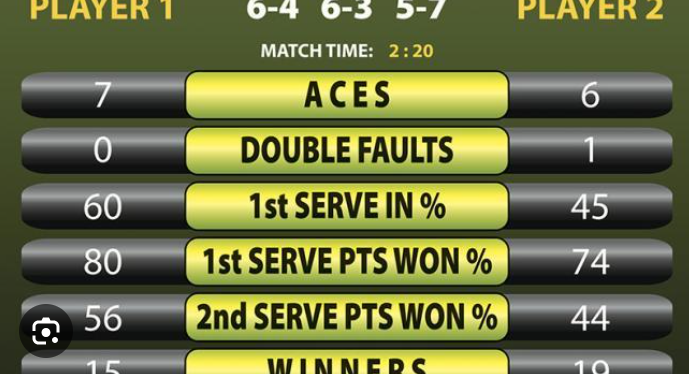In tennis, scores are broken down into points, games and sets. This unique scoring system gives the game its quirky flavour and has a number of impacts on the final results of matches.
Players swap ends of the court after each odd numbered point, and at the end of the set. If the score reaches 6-6, a tie break game is played to decide the set winner.
Origins
The scoring system in tennis results can be confusing for beginners, especially because it doesn’t have a consistent number of points like most other sports. This is because each point is awarded for a different outcome of a rally, from hitting a winner to an error or even to a cat running across the court! It might seem strange, but it’s important to understand how tennis scores work in order to get the most out of your game.
There are several theories about why the scoring in tennis works the way that it does. One theory is that it stems from medieval times when scoring was done by moving the hand of a clock. Since a full hour is 60 minutes, this meant that each point was worth 15 points. This led to the development of deuce and advantage scoring.
Another popular theory is that the score of zero in tennis is called love because it looks like an egg. The reason for this is that when tennis was first played in France centuries ago, the symbol used to represent a score of zero looked a lot like an egg. This led to the term “Love” being used to refer to a score of zero in tennis and other racquet games.
It is also possible that the scoring in tennis is so strange because of the different types of rallies that occur during a match. Each rally is unique and ends in a different way, whether the players hit a winner or lose the point due to an error or other factor. For this reason, it is important to keep track of the points and the game score so that you know what to expect at any given time.
The scoring in tennis also differs from other sports because there is no limit to how many points a player can win. This can cause frustration for players who are not able to break through a stubborn opponent. To avoid this problem, players should focus on improving their tactics and understanding the game of tennis.
Rules
The game of tennis has a number of rules that must be followed in order to play properly. The most important rule is that a player cannot touch the ball with their hands or any other part of their body during a point. If the player does this, they will lose the point. The players also have to hit the ball back and forth in the correct areas of the court for each point. This is known as a rally.
There are some special rules for tiebreak sets as well. If the set ends with an odd sum of games, the players will need to switch sides. This will determine who starts serving in the first game of the next set.
Unlike other normal sports, points in tennis are not counted like 1, 2, or 3. Instead, they are scored as 15, 30, and 40. This allows players to have a better idea of their scores during the game. In addition, if a player wins two consecutive points, they will win the set and the match. If they win one more point than their opponent, the game is a tie. Finally, the server must serve correctly in order to get a point. This means that the serve must be in the correct service area and not go over the net.
Equipment
Originally made of wood, rackets are now made of materials like carbon fiber. A ball, a net, and one player on each team are required for a tennis match. Tennis is a great workout and trains both your physical and mental health. It also requires a high level of social skills, especially when playing doubles. It is important to keep score when playing, and to avoid touching the net at any point in a point.
Scoring
Summer for tennis fans means clay courts, strawberries and cream, Wimbledon – and a lot of confusion over the scoring system. There are many theories on why the game is scored the way it is, and it may be difficult for beginners to understand at first, but once you’ve learned the basics, it will become much easier to follow.
The first step to understanding how tennis scoring works is determining what a “point” is. A point in tennis is any rally between two players that ends with one player winning by at least a two-point margin. There are a number of ways this can happen – the opponent may make an error, or he or she may hit a winner.
During a point, the umpire will announce the current score to both players. The server’s score is always called first, and then the receiver’s score. This is done to keep the score line clear for both players. The umpire will also state whether the player is serving or receiving.
If the point is tied, it is called deuce. If the player wins the next point, he or she will win the game. If the score is not won in this fashion, the game will continue until one player wins by a two-point margin. There have been some epic deuce battles in Wimbledon Finals over the years, and they make for great viewing.
A set in tennis is a sequence of games played, and is won by the first side to win six games. Once a set is won, the players switch court sides and start the next set. The players will change who serves and who returns in each set, as well as swapping ends after every odd-numbered game.
There are some different formats of tennis sets, but the best-of-one format is most commonly used in recreational and amateur matches. This format is more likely to last less than 90 minutes, and it allows both players to have a fair chance of winning the match. The other most common format is the five-set set, which is often used in professional tournaments. The most important thing to remember when playing tennis is that the more points you win, the better your chances of winning the game, set and match.
Conclusion
In conclusion, the tennis tournament showcased fierce competition and exceptional talent, leaving spectators on the edge of their seats. Top-ranked players demonstrated their prowess while underdogs fought bravely, resulting in thrilling matches. The event highlighted the sport’s enduring popularity and its ability to captivate audiences worldwide.
FAQs:
- Q: Who emerged as the champion of the tennis tournament? A: The champion of the tennis tournament was [Name], who displayed remarkable skills and determination throughout the competition, ultimately claiming victory in an intense final match.
- Q: Were there any notable upsets or surprises during the tournament? A: Yes, the tournament witnessed several surprising upsets as underdog players defeated higher-ranked opponents. These unexpected outcomes added excitement and unpredictability to the event, making it even more memorable for fans and players alike.



